The blogosphere is abuzz these days with romantic visions of picturesque miniature dwellings and the cost savings and lifestyle simplification they make possible. A growing number of local advocates say the tiny home movement could help achieve a wealth of positive outcomes, from reduced environmental impact to enhanced affordability.
In fact, several local builders now specialize in such structures, hoping to find business success that fits with their environmental values.
Amid the swelling interest, however, many hurdles remain. In addition to financial and legal barriers, the mainstream culture continues to trumpet the message that bigger is inherently better. And at the moment, there seem to be more people curious about tiny homes than folks willing to actually live in one. Still, if some of the ideas being kicked around now come to fruition, they could have a substantial local impact.

Upside of downsizing
Natalie Pollard has made her home in studio apartments, a trailer and even a tent cabin over the years. But Pollard, who owns the Villagers homesteading supply shop in West Asheville, has never lived any place as mini as the new 260-square-foot dwelling she’s preparing to move into.
There are several reasons for the move, says Pollard, who’s more recently been renting conventional houses in the neighborhood.
“Looking back, I realized I felt the most content and least burdened living in really small spaces,” she explains. “There’s less maintenance, less to worry about, less to fill. … A lot of it has to do with simplifying and ridding of extraneous responsibilities, so I have more time and, ironically, space in my life to do other things.” And then, she continues, “There’s the economical and practical side of things, as far as not wanting to be burdened with debt. … There’s the sustainable aspect of it too: less waste, less footprint.”
So Pollard commissioned Nanostead, a new Madison County-based business, to build her pint-sized residence. This is the company’s first foray into creating a mobile tiny home, but staffer Tony Beurskens hopes it won’t be the last. “We have dreams of building an assembly line for tiny homes,” he reveals. Pollard’s is taking shape on a 24-foot trailer in a vacant lot along Main Street in downtown Marshall, where its unusual size and shape have attracted plenty of attention. When it’s finished, perhaps next month, Pollard plans to display it outside her shop to help grow interest in the idea.
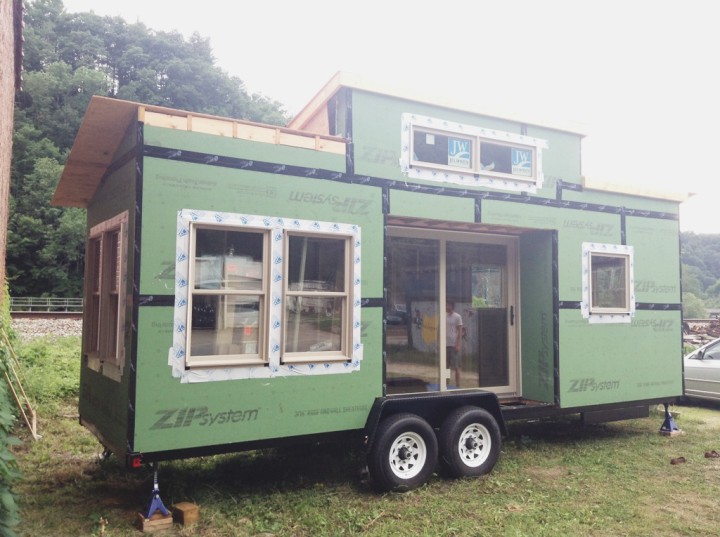
She’s also been blogging about the project throughout the design and construction phases. “It seems like every other customer is asking me about it,” she reports. “It’s sparking people’s interest, like, ‘Oh, is that something I might want to do?’”
But Pollard won’t be able to park her new quarters in West Asheville for long. Because she opted to have the home built on a trailer bed — a common practice — state law classifies it as a recreational vehicle, not a legal residence. As such, it’s licensed by the N.C. Division of Motor Vehicles; both Asheville and Buncombe County prohibit living in such vehicles, except in places like campgrounds and RV parks.
Give-and-take
Definitions of the tiny home vary, but the consensus seems to be that they’re livable structures under 400 square feet. According to CNN, the average new home built in the U.S. last year was 2,598 square feet — up from 2,330 square feet 10 years ago. The smallest tiny homes, on the other hand, range from 120 to 275 square feet, and they’re often built on trailers for convenience and ease of movement. But as Pollard learned, that places them in tricky legal territory.
“When I originally committed to this, I envisioned being in town, because I don’t like driving; I don’t like commuting,” she explains. Now, however, she’s planning to occupy a rural plot in Candler. There, she’s less likely to run afoul of the ban on permanently living in an RV, since cases are investigated only if someone complains.
Teal Brown, who co-founded Wishbone Tiny Homes earlier this year with his father, Gerry Brown, says quality is what sets their product apart. RVs, he explains, are typically sparsely insulated plastic-and-metal structures designed for travel, whereas Wishbone’s offerings come complete “with all the features of a traditional home,” only on a much smaller scale. A tour of their first model reveals well-insulated wooden walls and windows, custom handcrafted trim, intricately carved cabinets, modern kitchen appliances and bathroom fixtures, and a loft bed over the mostly open, 170-square-foot space. “They’re not fantastic travelers, but they are fantastic to live in, because you feel like you’re in a home,” notes Brown.
That craftsmanship has already attracted attention. The model home was featured at this spring’s Tiny House Conference in Charlotte, billed as the largest such gathering in the country so far, and the Downtown Raleigh Home Show has commissioned Wishbone to display the model there this fall. The business recently moved into the former Steebo Sculptures studio on Haywood Road and is hiring workers to help complete three more homes for clients.
Local interest, says Brown, has been overwhelming.
“The people that come to us range from college age all the way through retirement,” he reports. “For some, tiny houses represent an opportunity to downsize their lives, simplify and get away from what Western culture has encouraged for many years, which is acquiring more and more things and putting them in a bigger house.”
For others, affordability is the prime concern. Depending on size and features, Wishbone’s homes cost anywhere from $25,000 to $75,000, and Nanostead’s range from about $28,000 to $47,000, not including land and utility hookups. According to a report from Keller Williams Realty, the average home sale price in Buncombe County from December through May of this year was $258,391 (including land). Tiny home dwellers also have substantially lower utility bills.
For the local industry to reach its full potential, though, “There’s a social and political paradigm that needs to shift,” says Brown. Accordingly, he and others have begun organizing an as-yet-unnamed group that will push for changes in local and state rules to accommodate “implementing tiny homes in Asheville,” he explains. Meanwhile, the Asheville Tiny Home Association, launched last year to provide educational opportunities for do-it-yourselfers and to “let people know there’s another option,” now has 297 members, says founder Kristen Salvatore.
And though Brown’s group hasn’t yet formulated specific requests, he says, “We’re really looking forward to making ourselves known to the city. We don’t look at it as a battle but as a discussion, a give-and-take.”
Building a foundation
For those willing to place their small home on a permanent foundation, the law is already more forgiving. If care is taken to meet minimum state standards for kitchen, bathroom and living spaces, it’s possible to legally inhabit a home in Asheville that’s less than 250 square feet.
Marcus Barksdale, for example, has occupied the 240-square-foot dwelling he built in West Asheville since 2012. “It’s been fantastic. If you’re careful about how you design it, you can create a space that’s really fun and exciting to be in and won’t feel oppressive,” he maintains. “A lot of people think it means you live in a cramped little room, but that doesn’t have to be the case.” During construction, Barksdale recalls, more than 100 people came around to ask him about it, and now, he says, folks driving by often “stop, turn their heads and point. … I think people are surprised to see such a small building in town.” Barksdale’s home was also featured in the national Tiny House Blog.

Neighbors “have been super supportive,” he reports. But if the trend catches on and other city residents start becoming concerned about property values and related issues, notes Barksdale, he won’t be sympathetic. “As long as it meets all the rules, then it’s no one else’s business. Everyone has a right to build what they want where they want it.”
Downsizing from a 1,600-square-foot house in Montford enabled Barksdale to save money that had previously gone to pay a “huge mortgage,” he says. But having recently married, he’s now devoting much of those savings to renovating a 750-square-foot residence that will give the newlyweds a home office and the ability “to entertain guests a little easier.”
Changing circumstances
Green builder Barry Bialik says Barksdale’s need for more space is typical of what he hears from clients.
A pioneer in the local tiny home movement, Bialik says he built his first mobile unit about six years ago, but it ended up being his last, as he couldn’t find any buyers. Inspired by a previous stint living on a small houseboat in Seattle, “I thought there’d be more of a market for that, but I realized that there really wasn’t,” says Bialik, who also owns the Thirsty Monk Pub & Brewery.
Seeking greater market appeal and fewer legal barriers, Bialik went on to found The Compact Cottage Co., which now specializes in building bigger, “condo-size houses,” he explains. The most popular models run from about 1,000 to 1,400 square feet and range from around $100,000 to $150,000, not including land. Bialik says he’s having no problem selling them, either: The company typically has about five houses under construction at any given time, he reports.
And while he’s happy to see the buzz about tiny homes, Bialik says he’s confident that the houses he builds will continue to be a more practical option for most folks.
Longtime local builder Boone Guyton, a founding member of the WNC Green Building Council, agrees.
“There’s a lot of demand for smaller homes — around 1,000 to 1,200 square feet — but people still really like three bedrooms. It’s hard to get that in less and have any kind of reasonable size for each room,” Guyton explains. “I can’t imagine living in a 400-square-foot house for a long time. I see them as a beginning or something you add on to.”
Don’t tell that to Laura LaVoie, however. She and her husband say they have no plans to leave the 120-square-foot house in Madison County that they moved into in 2012. They both work out of their solar-powered home, and “The downscaling allowed me to quit my corporate job in Atlanta and pursue freelance writing, which is something I’d always wanted to do,” she explains. A keynote speaker at the Charlotte conference, LaVoie continues to document the experience in her blog, “Life in 120 Square Feet”; she’s also written a book titled 120 Ideas for Tiny Living.
“Everything I do for the tiny house community is really a labor of love,” says LaVoie. “It was the catalyst that changed my life, so I like to be able to share that with people.”
Welcome to the neighborhood?
Locals wanting to give tiny home living a try may soon have more options. Nanostead, says Beurskens, is exploring ways to partner with local campgrounds and RV parks to offer vacation rentals with the option of buying either a mobile or a fixed-foundation model afterward.
The idea is a spinoff of the concept pioneered by Caravan – The Tiny House Hotel in Portland, Oregon, a city often cited as a hotbed of tiny home enthusiasm.
And down in South Asheville, Sarah Gilgen hopes to erect four tiny homes on a half-acre plot she owns in the Shiloh neighborhood, creating a mini community of long-term renters.
Inspired by the documentary film TINY: A Story About Living Small, Gilgen says: “I wanted to be part of it in some way. … In America, it seems like the more stuff you have, the better. The cars should be big; you should own this and have that, and I am not about that.” Instead, she continues, “I would like to build up a little family, people that are like-minded — obviously they are, or else they wouldn’t be living in a tiny home — people that love the earth.” There’s a bus stop nearby, she says, and it’s less than a mile walk to the bars, restaurants and shops of Biltmore Village.
Gilgen has recruited Brown to help her with the project. More and more, he predicts, “You’re going to see tiny homes on foundations in infill areas and single-family lots.”
Meanwhile, although purists wouldn’t consider them “tiny,” plans for the proposed 169-acre Coggins Farm development in Riceville do include 12 to 24 homes in the 400- to 600-square-foot range. “We’ve been surprised by the appeal they have across a diverse swath of people,” says Nathan Taylor, a partner in the project. “The most common interests are as second/vacation homes or as a detached ‘in-law suite’ which could also be used as a … [vacation] type rental when not occupied by the owner. We don’t see much demand for tiny homes to replace regular single-family homes, though they could be an alternative to small apartments and condos.”
Tough nut to crack
But while tiny homes are significantly cheaper than traditional houses, the cost is still prohibitive for many residents — particularly since banks are often loath to provide financing.
“A lot of people who are interested in this don’t necessarily have $40,000 in the bank,” Beurskens points out. He previously worked for Green Opportunities, an Asheville nonprofit that helps people in poverty find environmentally friendly jobs. Beurskens and Brown both say they’d eventually like to partner with nonprofits to get people in need into their companies’ homes, but that will have to wait till their respective businesses are more established. In the meantime, Wishbone makes a $1,000 donation to either Green Opportunities or Habitat for Humanity, buyer’s choice, for every home it sells.
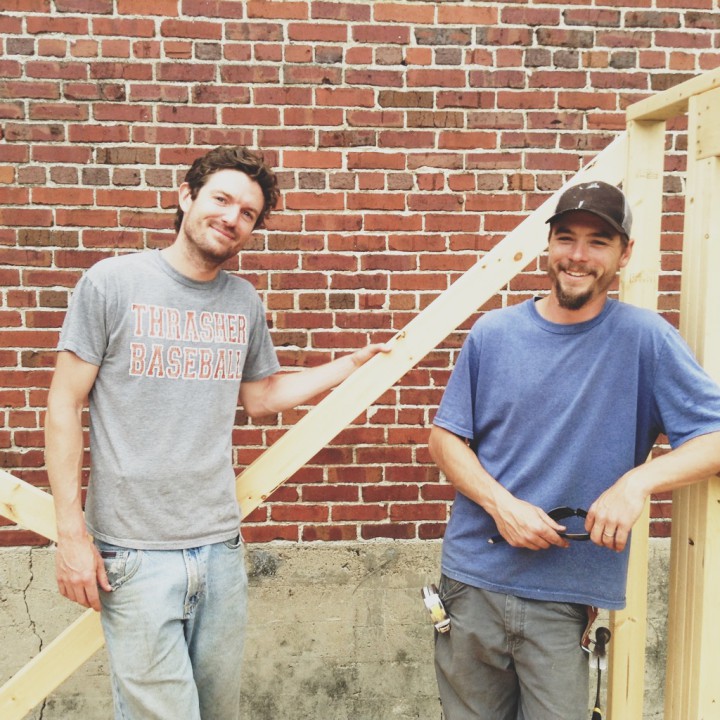
Another national trend is building tiny home villages to house the homeless — often at a fraction of the cost of conventional affordable-housing complexes. And in Alabama, notes Guyton, Auburn University’s 20K House project made national waves recently, developing several models that a contractor could build for $20,000.
In Asheville, however, it’s hard to find a buildable lot for less than $40,000, notes Bialik, and hooking up water and sewer lines costs about $8,000, regardless of the home’s size.
There’s no easy answer, Guyton maintains, saying,“Market-based affordable housing is really a tough nut to crack.”
Brown agrees. “Rent, as we all know, is insane in this town, and so is buying houses,” he says, adding that in the long term, he hopes Wishbone can be part of the solution.
LaVoie, too, believes increased tiny home living could be an important component of a broader answer to the puzzle of how we can improve local quality of life economically, environmentally and culturally. “So it seems like a good idea to get the subject on the table and try to figure out ways we can make it viable within our community,” she says. “Asheville’s really progressive, and if there’s anywhere in the Southeast that would be a good place to start this movement and get them legitimized, this is it.”
Next month, the Villagers shop in West Asheville plans to screen the documentary TINY: A Story About Living Small and host a forum on tiny home living. Shop owner Natalie Pollard will also display her own new tiny home. At this time, the date and details are still being finalized. This post will be updated with the details when they’re available.
UPDATE: Pollard and the Asheville Tiny Home Association will host a community discussion, film screening and small house exhibit on Monday, Aug. 25. Details here.



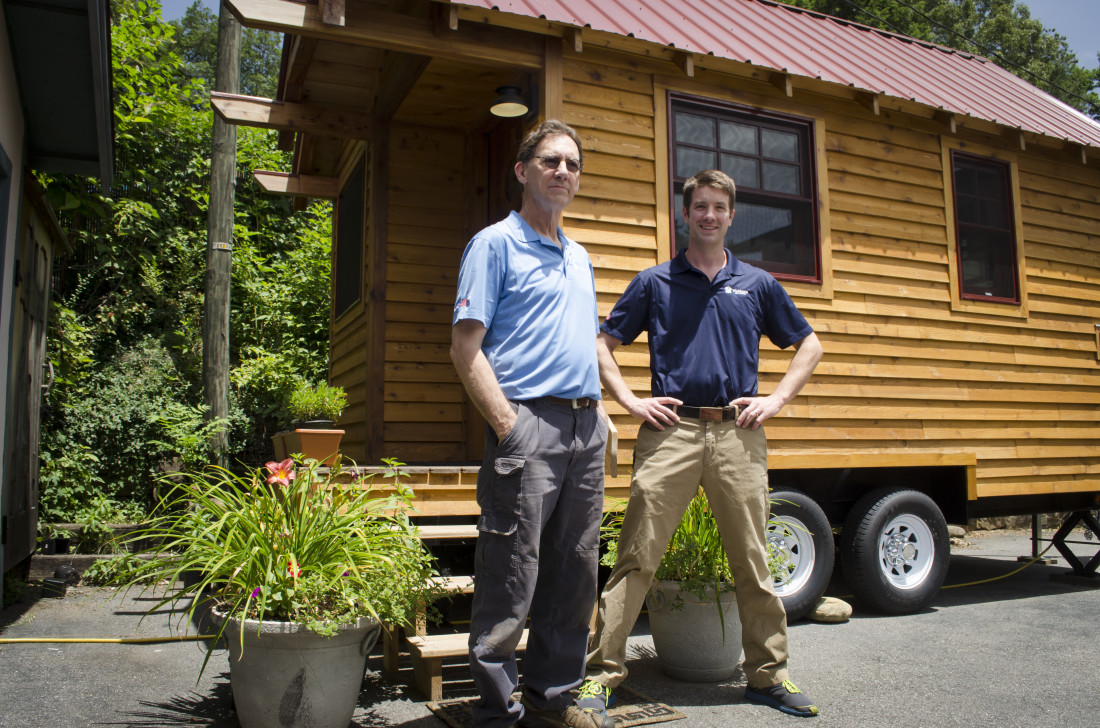

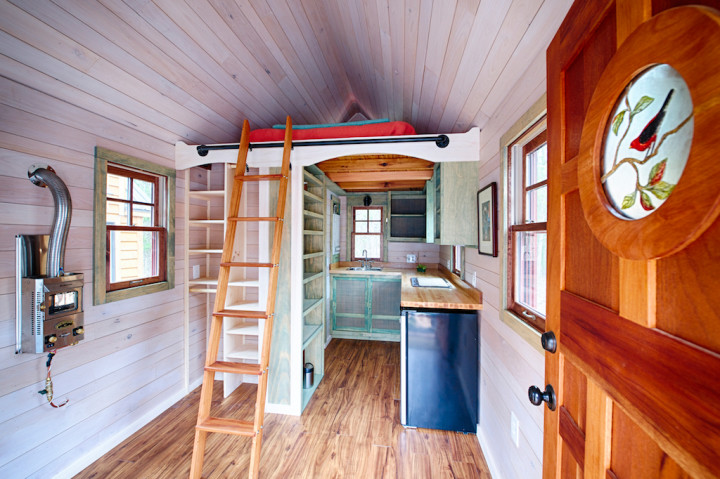
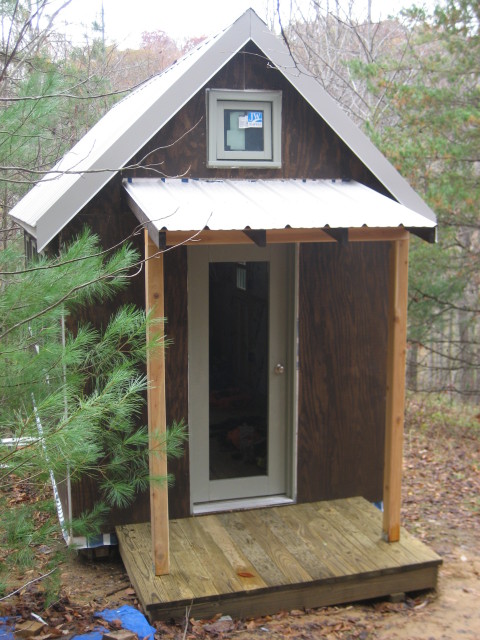

Also coming are YURT villages for even less expensive seasonal housing 8 months out of the year…
Nice, and well thought out.
But as the previous poster wrote, a yurt makes more sense. Better space, made of aircraft grade material, and $10k will get you one big enough to host a blue grass gathering. http://www.yurts.com.
Please, more articles about the next:
“Big thing”
“Putting us on the map”
“Game Changer”
“Epic” anything
“Scene”
Oops, I forgot:
“Big Draw”
Watch Tiny House Nation tonight on FYI at 10pm. We live in Erwin, TN just 50 mins from Asheville and they will featuring the tiny house, 331 sq. ft, that was built on our Nolichucky River frontage.
We love our tiny house and tiny house living!
A trend? Maybe. I hope it’s not just a temporary trend but a long lasting shift from being what I call “slave to the cave”. When I consider all the life time I have spent acquiring, cleaning, maintaining and just plain serving the house I can’t help but wonder how I came to believe this was a rewarding and fulfilling way to spend a life. It’s nice to think that maybe my kids will avoid the conventions that make them work a job with the goal of having nice stuff for the occasional garage sale. This single shift in housing methods and the necessarily resultant constraint on “consumption to be happy” could have profound impacts, but it could just create a boom in the storage building rental business. I hope not.
Check this company out, surprised they aren’t mention here, it’s based in Asheville too. Awesome houses and very unique designs by Malissa Tack.
http://www.projectwosho.com
http://www.evidenceaid.org/robertomjunior/d9fbb-71387-58.htmlティファニー 店舗 東京,ティファニー 指輪 婚約,ニナリッチ 財布 小銭入れ
ティファニー 婚約指輪 口コミ,ティファニー 婚約指輪 予算,ニナリッチ 香水 トマト http://www.l-ement.com/robertomjunior/d78aa-61386-54.html
We’re your neighbors, as it turns out. I loved the video tour of your house. We (me and my husband, Markus) live in the Bend of Ivy, about 5 miles out of Marshall, near Jupiter. We’ve thought about building a tiny house as a second space—possibly to double as my library, but also serve as a guest house. In any case, perhaps we’ll run into you sometime in Zuma, in Marshall.